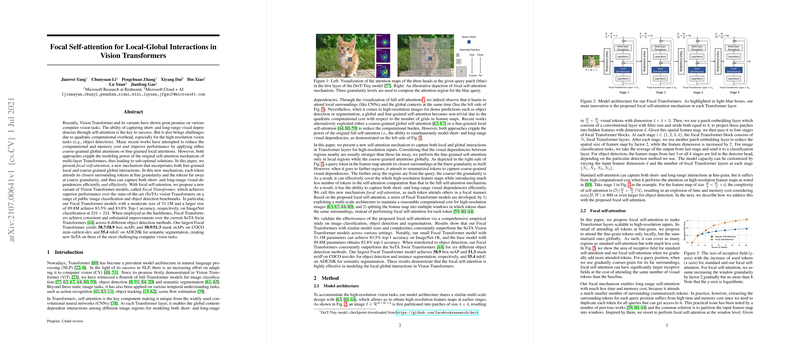An Examination of Focal Self-Attention for Enhanced Vision Transformers
The academic landscape of computer vision has been significantly altered by the introduction of Vision Transformers (ViTs). The promise of these models lies in their ability to naturally capture both short- and long-range dependencies, a task previously managed independently through distinct model architectures. However, the self-attention mechanism intrinsic to ViTs is computationally intensive, particularly for high-resolution tasks such as object detection. In the discussed paper, the authors propose a novel approach, termed focal self-attention, integrating local and global attention methodologies into ViTs to surmount these computational challenges while enhancing performance.
Overview of Focal Self-Attention
Focal self-attention is introduced as a mechanism that amalgamates fine-grained local attention with coarse-grained global attention. This dual-focused attention allows each token to attend to its immediate neighbors with high granularity, while also considering distant tokens in a summarized form. Through this method, the paper introduces a new class of Vision Transformers, Focal Transformers, designed to efficiently capture both local and global dependencies.
The complexity of focal self-attention is optimized by partitioning an input feature map into several windows, thus reducing the number of tokens that need to be processed globally. The computational cost is thus not quadratic relative to the number of grids but rather linear concerning the window size—a significant advancement in terms of computational efficiency for high-resolution images.
Key Results
The Focal Transformer models, equipped with the focal self-attention, demonstrated superior performance metrics across various computer vision benchmarks. On the ImageNet classification task with a $224 \times 224$ input size, Focal Transformers achieved a Top-1 accuracy of 83.5% and 83.8% with moderate and larger model scales, respectively. These results surpass those of equivalent state-of-the-art ViTs.
Furthermore, when evaluated as backbone models for object detection tasks on the COCO dataset, Focal Transformers consistently outperformed SoTA Swin Transformers across six different object detection methods. The largest variant achieved box mean Average Precision (mAP) scores of 58.7/58.9 and mask mAP scores of 50.9/51.3 on the COCO mini-val/test-dev sets. Additionally, they scored 55.4 mean Intersection over Union (mIoU) for semantic segmentation on ADE20K, setting new records across these tasks.
Theoretical and Practical Implications
The proposed focal self-attention presents a comprehensive framework capable of capturing intricate local-global interactions efficiently. The results infer a robust architectural blueprint, addressing computational inefficiencies endemic to existing ViTs, while not compromising on the quality of task execution, especially at high resolutions.
One of the most salient theoretical implications of this research is its demonstration of the efficacy experienced when local and global dependencies are treated within a unified framework. Previously, the computational divide between coarse-grained global and fine-grained local attention mechanisms led to suboptimal solutions; however, the focal approach provides a seamless paradigm interlinking these elements advantageously.
Future Prospects
The adaptation of focal self-attention across even broader applications within and beyond the field of visual tasks serves as an exciting prospect. Potential research paths could explore its effectiveness and potential refinements in other domains benefiting from attention mechanisms, such as natural language processing, where long-range dependencies are likewise crucial.
There remains an opportunity to further optimize complexity and realign the parameters governing focal attention's effective scope, perhaps facilitating deployment on resource-constrained devices. Additionally, evolving the underlying architecture to include unsupervised learning capabilities could potentiate broader adoption and versatility.
Conclusion
Focal self-attention marks a significant contribution to the field of computer vision and the evolution of Transformer models. By offering an efficient means of processing high-resolution data while leveraging both local and global informatics, this paper sets a new performance baseline for ViTs, providing a robust foundation for future exploration and application in AI.
